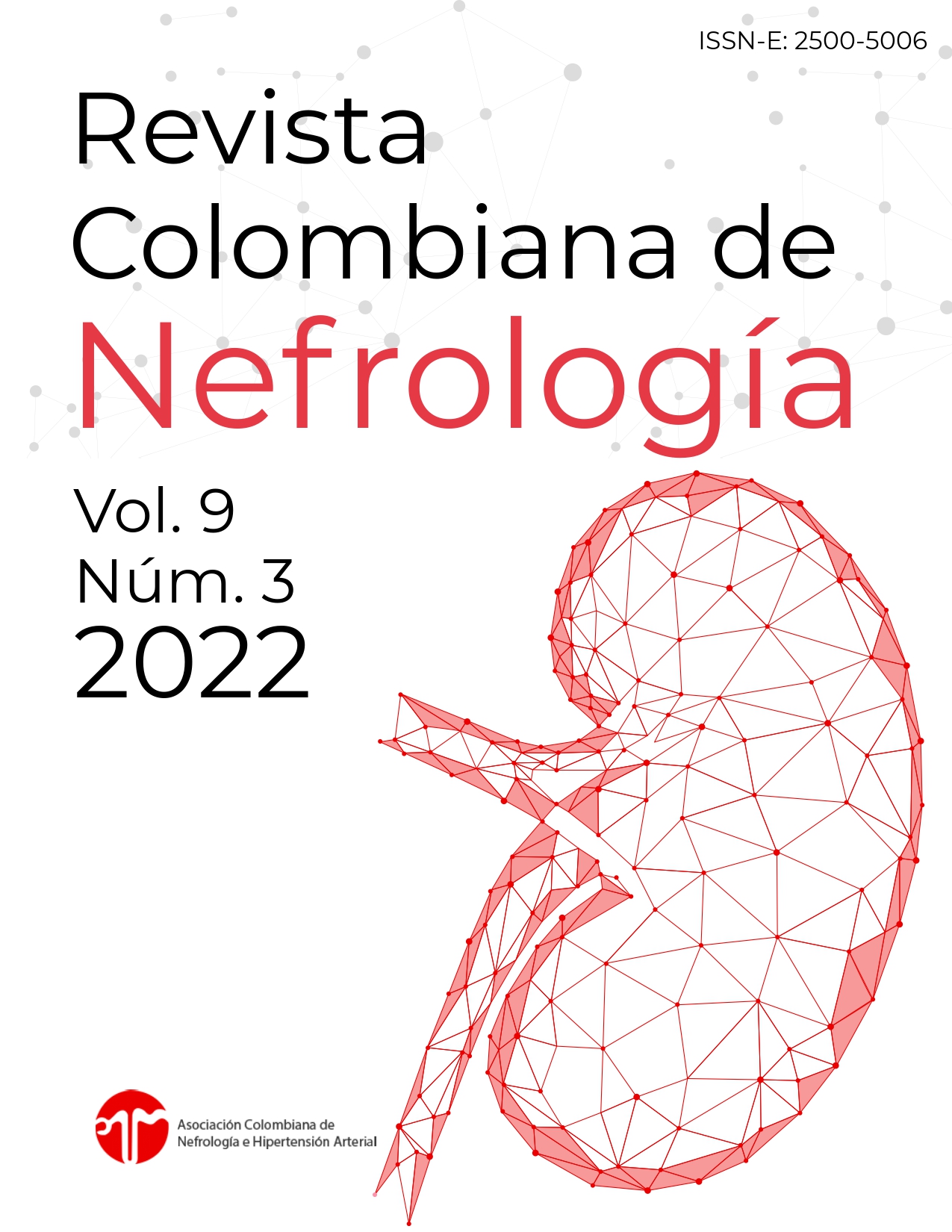Abstract
Introduction: Kaposi sarcoma in post-renal transplantation patients is a rare entity, usually associated with herpes 8 infection and high doses of immunosupresion.
Purpose: Case report description of Kaposi's sarcoma in the oropharynx in a post-renal transplant patient managed with co-stimulation signal inhibitor and mTOR inhibitor.
Case presentation: This article describes the case of a patient, with a history of renal transplant, with a diagnosis of Kaposi's sarcoma in a very rare location: oropharyngeal level. A review of the risk factors, pathogenesis and a management approach is made. Likewise, a follow-up and management with co-stimulation signal inhibitor (belatacept) and mTOR inhibitor is performed.
Discussion and conclusion: Kaposi's sarcoma is one of the post-transplant neoplasms with the highest incidence compared to the non-transplanted population, where the role of viral infection reactivation, plus the role of immunosuppression, are fundamental points in the genesis of the neoplasm. The determination of IgG serological status for HHV8 could be a strategy to determine risk in pretransplantation.
References
Jeong S, Lee HS, Kong SG, Kim DJ, Lee S, Park MJ, et al. Incidence of malignancy and related mortality after kidney transplantation: a nationwide, population-based cohort study in Korea. Sci Rep. 2020;10(1):21398. https://doi.org/10.1038/s41598-020-78283-5
Au E, Wong G, Chapman JR. Cancer in kidney transplant recipients. Nat Rev Nephrol. 2018;14(8):508-20. https://doi.org/10.1038/s41581-018-0022-6
Cheung CY, Tang SC. An update on cancer after kidney transplantation. Nephrol Dial Transplant. 2018;34(6):914-20. https://doi.org/10.1093/ndt/gfy262
Gao SJ, Kingsley L, Hoover DR, Spira T, Rinaldo C, Saah A, et al. Seroconversion to antibodies against Kaposi's sarcoma-associated herpesvirus-related latent nuclear antigens before the development of Kaposi's sarcoma. N Engl J Med. 1996;335:233. https://doi.org/10.1056/NEJM199607253350403
Hosseini-Moghaddam S, Soleimanirahbar A, Mazzulli T, Rotstein C, Husain S. Post renal transplantation Kaposi’s sarcoma: a review of its epidemiology, pathogenesis, diagnosis, clinical aspects, and therapy. Transpl Infect Dis. 2012;14(4):338-45. https://doi.org/10.1111/j.1399-3062.2011.00714.x
Mittal A, Colegio OR. Skin Cancers in Organ Transplant Recipients. Am J Transplant. 2017;17:2509. https://doi.org/10.1111/ajt.14382
Moosa MR. Racial and ethnic variations in incidence and pattern of malignancies after kidney transplantation. Medicine. 2005;84:12. https://doi.org/10.1097/01.md.0000152372.30370.6f
Cahoon EK, Linet MS, Clarke CA, Pawlish K, Engels E, Pfeiffer R. Risk of Kaposi sarcoma after solid organ transplantation in the United States. Int J Cancer. 2018;143:2741. https://doi.org/10.1002/ijc.31735
Moosa MR. Kaposi's sarcoma in kidney transplant recipients: a 23-year experience. QJM. 2005;98:205. https://doi.org/10.1093/qjmed/hci028
Frías SJ, Julián CA. Kaposi's sarcoma in oral cavity. Enf Infec Microbiol. 2010;30(3):100-5.
Figueroa E, López LD, Navarrete G. Sarcoma de Kaposi. Revisión de la literatura, un enfoque en la etiopatogenia. Dermatología CMQ. 2018;16(2):128-33.
Francès C, Mouquet C, Marcelin AG, Barete S, Agher R, Charron D, et al. Outcome of kidney transplant recipients with previous human herpesvirus-8 infection. Transplantation. 2000;69:1776. https://doi.org/10.1097/00007890-200005150-00008
Barozzi P, Luppi M, Facchetti F, Mecucci C, Alù M, Sarid R, et al. Post-transplant Kaposi sarcoma originates from the seeding of donor-derived progenitors. Nat Med. 2003;9:554. https://doi.org/10.1038/nm862
Emond JP, Marcelin AG, Dorent R, Milliancourt C, Dupin N, Frances C, et al. Kaposi's sarcoma associated with previous human herpesvirus 8 infection in heart transplant recipients. J Clin Microbiol. 2002;40:2217. https://doi.org/10.1128/JCM.40.6.2217-2219.2002
Ponticelli C. Herpes viruses and tumours in kidney transplant recipients. The role of immunosuppression. Nephrol Dial Trans. 2011;26(6):1769-75. https://doi.org/10.1093/ndt/gfr157
Le J. Oncogenic ? Herpesviruses EBV and HHV8 in Kidney Transplantation. Semin Nephrol. 2016;36(5):362-71. https://doi.org/10.1016/j.semnephrol.2016.05.013
Zhang B, Kracker S, Yasuda T, Casola S, Vanneman M, Hömig-Hölzel C, et al. Immune surveillance and therapy of lymphomas driven by Epstein-Barr virus protein LMP1 in a mouse model. Cell. 2012;148:739. https://doi.org/10.1016/j.cell.2011.12.031
Szymula A, Palermo RD, Bayoumy A, Groves I, Ba Abdullah M, Holder B, et al. Correction: Epstein-Barr virus nuclear antigen EBNA-LP is essential for transforming naïve B cells, and facilitates recruitment of transcription factors to the viral genome. PLoS Pathog. 2019;15:1007403. https://doi.org/10.1371/journal.ppat.1007403
Neale RE, Weissenborn S, Abeni D, Bouwes JN, Euvrard S, Feltkamp M, et al. Human papillomavirus load in eyebrow hair follicles and risk of cutaneous squamous cell carcinoma. Cancer Epidemiol Biomarkers Prev. 2013;22:719. https://doi.org/10.1158/1055-9965.EPI-12-0917-T
Nindl I, Gottschling M, Stockfleth E. Human papillomaviruses and non-melanoma skin cancer: basic virology and clinical manifestations. Dis Markers. 2007;23:247. https://doi.org/10.1155/2007/942650
Santos-Juanes J, Fernández-Vega I, Fuentes N, Galache C, Coto-Segura P, Vivanco B, et al. Merkel cell carcinoma and Merkel cell polyomavirus: a systematic review and meta-analysis. Br J Dermatol. 2015;173:42. https://doi.org/10.1111/bjd.13870
Schowalter RM, Pastrana DV, Pumphrey KA, Moyer A, Buck C. Merkel cell polyomavirus and two previously unknown polyomaviruses are chronically shed from human skin. Cell Host Microbe. 2010;7:509. https://doi.org/10.1016/j.chom.2010.05.006
Clarke CA, Robbins HA, Tatalovich Z, Lynch C, Pawlish K, Finch J, et al. Risk of merkel cell carcinoma after solid organ transplantation. J Natl Cancer Inst. 2015;107. https://doi.org/10.1093/jnci/dju382
Ming M, Zhao B, Qiang L, He YY. Effect of immunosuppressants tacrolimus and mycophenolate mofetil on the keratinocyte UVB response. Photochem Photobiol. 2015;91:242. https://doi.org/10.1111/php.12318
Dantal J, Soulillou JP. Immunosuppressive drugs and the risk of cancer after organ transplantation. N Engl J Med. 2005;352:1371. https://doi.org/10.1056/NEJMe058018
Hojo M, Morimoto T, Maluccio M, Asano T, Morimoto K, Lagman M, et al. Cyclosporine induces cancer progression by a cell-autonomous mechanism. Nature. 1999;397:530. https://doi.org/10.1038/17401
Guba M, Graeb C, Jauch KW, Geissler EK. Pro- and anti-cancer effects of immunosuppressive agents used in organ transplantation. Transplantation. 2004;77:1777. https://doi.org/10.1097/01.TP.0000120181.89206.54
Stallone G, Schena A, Infante B, Di Paolo S, Loverre A, Maggio G, et al. Sirolimus for Kaposi's sarcoma in renal-transplant recipients. N Engl J Med. 2005; 352:1317. https://doi.org/10.1056/NEJMoa042831
Lebbé C, Euvrard S, Barrou B, Pouteil-Noble C, Garnier JL, Glotz D, et al. Sirolimus conversion for patients with posttransplant Kaposi's sarcoma. Am J Transplant. 2006;6:2164. https://doi.org/10.1111/j.1600-6143.2006.01412.x
Andrassy J, Guba M, Habicht A, Fischereder M, Pratschke J, Pascher A, et al. Early conversion to a CNI-free immunosuppression with SRL after renal transplantation-Long-term follow-up of a multicenter trial. PLOS ONE. 2020;15(8):e0234396.
Knoll GA, Kokolo MB, Mallick R, Beck A, Buenaventura CD, Ducharme R, et al. Effect of sirolimus on malignancy and survival after kidney transplantation: systematic review and meta-analysis of individual patient data. BMJ. 2014;349:g6679. https://doi.org/10.1136/bmj.g6679

This work is licensed under a Creative Commons Attribution-NonCommercial-NoDerivatives 4.0 International License.


